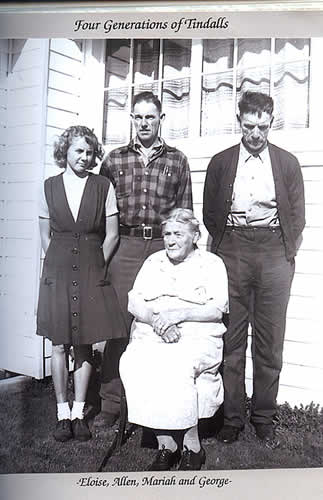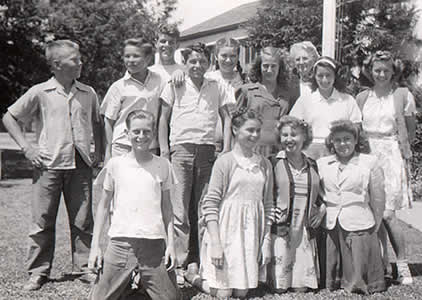Eloise is a fourth generation Corralitos Tindall. She was born during the Great Depression to Allen and Alice Johnson Tindall. They were living near the Five-Mile House at the time, but soon after moved to a new home by the Corralitos store.

One of my earliest memories is of my dad working at 4-H camp up in Eureka Canyon. His job was to ride a horse through the woods to watch for fire during the summertime. My mom and I would camp up there with him. Because I was allergic to milk, she would bring a goat along with us. When the time came for me to attend school, I went to a four-room schoolhouse in Corralitos on Aldridge Lane. Two grades were taught in each room, from first to eighth grade. I lived close enough so I could walk to and from school and come home for lunch everyday. When I was seven years old my sister Janet was born. I went to Sunday School at the Free Methodist Church on Brown’s Valley Road. I was a Corralitos 4-H Club member and raised rabbits. My mom didn't work outside the home until Janet and I were grown.
Although my parents weren't members, they and many other local people were active in the Farm Bureau. They were, however, members and very involved in the Grange. I have memories of my parents taking me along to the dances, where I would sleep on a bench in the back. They helped maintain the Grange Hall. It was also used as an auditorium by the school. I remember when the school got hard-boiled eggs from the government and when the Work Project Administration was formed. They worked on dams and built ditches, making way for people to eventually get into county or city jobs. They provided room and board for some. Because there were more people than jobs, the WPA received a nickname, ‘We Piddle Around.’ (People also found a nickname for the women's liberation movement, ‘Women's Lip.’) The WPA donated dresses to the young girls, but my father wasn't a member so I wasn't able to receive them. I traded dresses with other girls at school. My family along with many others had the bare necessities yet nobody complained or wished they had other things. ‘Keeping up with the Jones(es)’ was not a priority.
Time passed and by 1941, the country was in the middle of a war. The massive production of war materials ended the depression. Most Americans tended to be isolationists, yet when Pearl Harbor was bombed on December 7, 1941, Americans got ready to protect their country at all costs. Everybody played their part in supporting the war effort. Patriotism flourished and no one was free from the effects of war, whether they had to give up their routine Sunday drive because of gas shortages, or send their sons off to war. Everybody, young and old, played their part by saving bacon grease, aluminum foil, tire rubber, old nylons and the like to be made into materials for war. Sugar and coffee were the first to be rationed starting in 1942. Processed foods followed next, then meat, fish, and dairy products. Every person was issued two ration books each month. One had forty-eight points for canned goods and one contained sixty-four red points for fish, meat, and dairy products. A housewife buying for a family of four had one hundred-and ninety two points to use as she chose. The number of points for every food item fluctuated depending on availability. One month applesauce would be ten points, and six months later it could be twenty-five points. Making points redeemable for only a certain period of time, prevented hoarding of stamps. Gas was rationed by assigning windshield stickers with a priority letter from A to E. Pleasure drivers got A stickers which were worth three to five gallons per week. Commuters got B stickers worth varying amounts of gasoline based on their distance from work. L stickers were for emergency workers, policemen, clergy and farmers. These were worth unlimited amounts of gas. The average citizen was issued ten gallons of gas per month. Many stores posted ‘No cigarettes’ signs, although many had ‘stoopies,’ the kind you stoop behind the counter for.
‘Make yours a victory home’ was the slogan that unified neighborhoods everywhere. Victory gardens were promoted by the Secretary of State. Families were encouraged to make themselves into a fighting unit on the home front so they could earn the ‘V’ home certificate. By conserving food, salvaging materials, buying war bonds, and refusing to spread rumors that could divide the nation, a family could receive this honor. When we had to practice air raid drills at school, we would have to get wet paper towels to hold in our mouths and run for the flume, a deep ditch on the property outside the school. ‘Now how would an open flume protect us?’ I wonder. The teachers made name tags out of oilcloth tablecloths and hung them around the student's necks with yarn. Communities had lookouts for planes and people would take turns being ‘observers.’ In 1945, the year FDR died, I was in seventh grade. I was out playing baseball at school with some friends and some of the mothers came and delivered the news. The moms and teachers were crying, and everybody was wondering about ‘what we were going to do.’
When I was in the eighth grade, I babysat for Jim and Barbara Prendergast. Jim asked me to work in the store as a clerk. I worked there all through high school and for about three years after. I ran the butcher shop and T.J. Wisdom ran the store when Jim was ill. Jim had taught me how to cut meat, grind hamburger, and use the smokehouse. Then, I knew just about everybody in Corralitos. They came in to shop and visit. People could charge their groceries and pay by the month.

Eloise on far right with eighth grade class and Elma G. Bradley
When I was a freshman at Watsonville High School, my family moved to the property on Hames Road where I live today. Roy Wilson was in high school when I was. I knew of him because he played football and also because one of my friends was dating him at the time. I found out everything I could about him from my friend, my motive being to
meet him. I got chances to spend time with him at the Corralitos Grange dances and liked what I saw. We soon started dating and ‘that was the end of the other girlfriend.’ Roy lived with his family in Aromas. He worked on a farm bailing hay and working with cattle. We saw each other at school and on the weekends towards the end of my sophomore year.
It was October of 1950 when we married. We rented a little house across the road from where the Rowlee’s had once lived in Buzzard Lagoon. A storm came and washed
out the canyon and they had to haul our new presents out by wheelbarrow. Since we didn’t have access to our house anymore, my mom set up a little cabin on their property for us. It had no bathroom and it was small, but it gave us a place to stay until we could find another place. We soon found a house down the road to rent for forty-five dollars a month and moved in there. Meanwhile, we began making plans to build a house on my parents’ property. We started building in 1951, with all the lumber coming from the Tindalls’ Eureka Canyon ranch.
